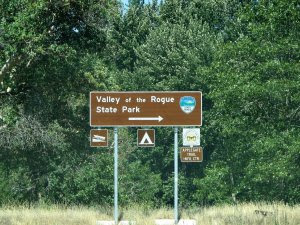Many years ago Kathy and I, on a lark, started taking classes in Scottish Gaelic and had lots of fun in them (we had a superb teacher). It didn't hurt that a few months later after a business trip to the UK that we got to tour the Gaidhealteachd (the Gaelic-speaking regions of Scotland) – somewhere I have packed away a bumpersticker that announces “I have a tiger in my tank” (remember that gasoline company ad?) in Gaelic.
 And a few years later we visited the town of Glen Innis, Australia. Proud of its Gaelic history it features a Stonehenge designed for its locale, bilingual Gaelic/English street-signs, and a plaque about its founding – which we discovered says a bit more in the Gaelic than it does in English!
And a few years later we visited the town of Glen Innis, Australia. Proud of its Gaelic history it features a Stonehenge designed for its locale, bilingual Gaelic/English street-signs, and a plaque about its founding – which we discovered says a bit more in the Gaelic than it does in English!
In any event, although Seattle's increasing wretched traffic situation forced us to drop the classes, we've retained our ties to Seattle's Scottish Gaelic society, Slighe nan Gaidheal (SnG), and occasionally perform “waulking songs” with them.
“Waulking songs” are traditional songs sung during the communal work activity of “waulking”/milling/fulling newly-woven tweed – in essence, beating it by hand upon a table to where the woven threads interlock and make a thicker, more wind and water resistant fabric. There are a number of traditions bound up with waulking songs, which generally follow the themes of love lost or gained, jealousy, or war. Though an ancient tradition, (waulking songs tend to be quite old, some of them maybe older than the English language), they have survived into current times – though the practice of waulking itself is now dying out in Gaelic Scotland and Nova Scotia.
Like most working songs, waulking songs have a fairly simple structure. There is a leader who sings the song itself. The group sings a response and/or refrain, usually nonsense syllables (“hey diddlery-o / hey diddle-i o” an Irish-style example), though standardized and unique to the song. Many are known by these non-sense “vocables,” the song “Hey Man-du” being an example.
So Sunday Kathy and I are on deck to perform a set of waulking songs with SnG. We weren't really prepared, but they found they have nobody who can belt out “An Toll Dubh” (The Dungeon, lit. “The Black Hole”) the way she can. And “Alastair Mhic” has become another of her signature leads. So we're on to perform.
 Unlike most of our SnG performances, this one is in part “re-enactment”. We usually dress in jeans & t-shirt (SnG shirts preferred), but for this one we're to dress in “period” dress. I have my “Braveheart”-style great-kilt (no woad/blue-paint), and Kathy her araisaid (example depictured), but there is no place/opportunity for me to change at church. I simply have to come in costume – no disrespect intended.
Unlike most of our SnG performances, this one is in part “re-enactment”. We usually dress in jeans & t-shirt (SnG shirts preferred), but for this one we're to dress in “period” dress. I have my “Braveheart”-style great-kilt (no woad/blue-paint), and Kathy her araisaid (example depictured), but there is no place/opportunity for me to change at church. I simply have to come in costume – no disrespect intended.
This is my dilemma (“tha imcheis agam”); we may have to explain our dress, tha mi a' smaoineachadh, but oh well.
Update: The reaction was interesting -- we caught some folks completely by surprise. We did reassure a visitor that we don't come like this every Sunday (grin). And Oma had to have her picture taken with us, as she was returning to Scotland this week. But over all it was: "Are we having bagpipes today?" Sadly, no.

























